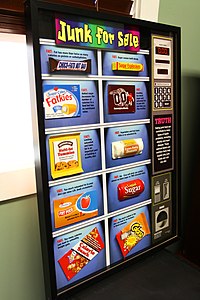
Photo from wikipedia
Background: Food labeling is a fundamental educational tool for advocating for public awareness. It emphasizes knowledge of the nutrient content of food and thus directs the choice towards the healthiest… Click to show full abstract
Background: Food labeling is a fundamental educational tool for advocating for public awareness. It emphasizes knowledge of the nutrient content of food and thus directs the choice towards the healthiest food products. This cross-sectional survey aimed to assess the knowledge, attitudes, and practices (KAP) regarding nutrition label use in Lebanon through a valid questionnaire. Methods: Overall, 768 participants (mean age: 30.8 ±12, males: 60.2%) were recruited randomly between February and May 2020. We used word of mouth and social media to recruit our sample population. Results: Social media was the most accessed tool to attain nutrition information by responders (39.8%). More than half the participants expressed positive attitudes to check information related to sugars (66.4%), vitamins (64.9%), total fats (61.7%), proteins (59.1%), and calories (58.7%) on the food label. Expiry date, price, and brand name were the top three considerations while reading food labels. About half (46.5%) reported to "always" look at the food label. Responders reported reading labels related primarily to sugars (44.3%), calories (38.8%), and total fats (36.8%). The optimal total KAP score was 46; our findings revealed a mean KAP score of 14.46 ±7 (31.4%). When categorizing the KAP scores, 15% had high scores, and 85% scored low. Spearman's coefficients showed positive correlations between knowledge-attitude, knowledge-practice, and attitude-practice scores, with p<0.001. The regression analysis revealed that gender, age, BMI, residency area, educational level, university degree, health and diet statuses, and activity level were significant predictors of the KAP score. Being on a diet had the highest odds (OR=3.107, CI=1.904-5.072, p<0.001). Conclusion: The low awareness of food labels leads Lebanese people to choose unhealthy food options. A planned educational program is recommended to ease the interpretation of these labels.
Journal Title: F1000Research
Year Published: 2022
Link to full text (if available)
Share on Social Media: Sign Up to like & get
recommendations!